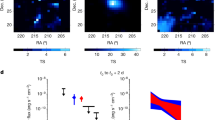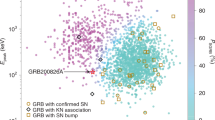Abstract
THE γ-ray source CG195+4 (Geminga) discovered by SAS 2 and further observed by COS B has a period of 59 s which is increasing at a rate Ṗ = 2×10−9 (refs 1,2). If the periodicity is produced by a neutron star which is spinning down at the observed rate, then the rate at which rotational energy is being lost is L ∼ 3×1032 erg s−1 (ref. 3). The observed γ-ray flux of 3×10−6 photon cm−2 s−1 with energy E>100 MeV implies that the distance, d, to the source is given by d ≃ 73f1/2 pc where f(≳ 1) is the fraction of the total energy output which is emitted as γ-rays. Theoretical studies of the evolution of binary systems which give rise to the binary X-ray sources have led to the suggestion that, before the neutron star starts to accrete and spin up (that is, before the X-ray source turns on) it spends a comparatively long time being spun down in the weak stellar wind of its companion4. This leads us to seek a candidate companion for the γ-ray source which is an early type star at a distance of ≳ 70 pc. As we report here, the only object which satisfies these constraints is γ Geminorum.
This is a preview of subscription content, access via your institution
Access options
Subscribe to this journal
Receive 51 print issues and online access
$199.00 per year
only $3.90 per issue
Buy this article
- Purchase on Springer Link
- Instant access to full article PDF
Prices may be subject to local taxes which are calculated during checkout
Similar content being viewed by others
References
Thompson, D. J. et al. Astrophys. J. 213, 252–262 (1977).
Masnou, J. L. et al. Proc. 12th ESLAB Symp. (1977).
Maraschi, L. & Treves, A. Astr. Astrophys. 61, L11–L13 (1977).
van den Heuvel, E. P. J Proc. 8th Texas Symp., New York Acad. Sci. (in the press).
Johnson, H. L. & Morgan, W. W. Astrophys. J. 117, 313–352 (1953).
Palmer, D. R., Walker, E. N., Jones, D. H. P. & Wallis, R. E. R. Obs. Bull. No. 135 (1968).
Beardsley, W. R. I.A.U. Symp. No. 30 (eds Batten, A. H. & Heard, J. F.)(1967).
Reimers, D. Proc. I.A.U. Coll. No. 42, Bamberg, (in the press).
Arons, J. & Lea, S. M. Astrophys. J. 207, 914–936 (1976).
Elsner, R. F. & Lamb, F. K. Astrophys. J. 215, 897–913 (1977).
Harper, W. E. Publ. Dom. astr. Obs. 6, 223 (1935).
Author information
Authors and Affiliations
Rights and permissions
About this article
Cite this article
DAVIES, R., FABIAN, A. & PRINGLE, J. γ-Rays from γ Geminorum?. Nature 271, 634–635 (1978). https://doi.org/10.1038/271634a0
Received:
Accepted:
Issue Date:
DOI: https://doi.org/10.1038/271634a0
This article is cited by
-
Hard X-ray observations of cosmic γ-ray sources
Nature (1978)
Comments
By submitting a comment you agree to abide by our Terms and Community Guidelines. If you find something abusive or that does not comply with our terms or guidelines please flag it as inappropriate.



